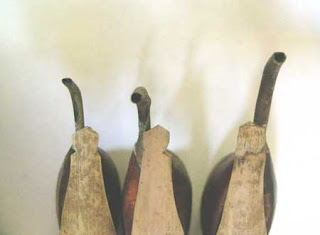Canting section consists of three parts namely:
Nyamplung: bin where the liquid night, made of copper.
Beak: affiliated with nyamplung, is where the discharge pipe hot night while writing batik.
Handles: the handle canting, generally made of bamboo or wood.
Canting is used like a pen when you write normally, various sizes depending on the type of batik are about to be made. When used, batik Indonesia will take a "candle" the so-called "night" is in the frying pan into the "nyamplung". Then canting appointed and "beak" blown a little to lower the temperature. Candles are still in the liquid state is then etched through the "beak" to the batik cloth to form the painting upside down. The results from the canting wax nicks it will be free from actual batik colors so that part is free of wax will be colored if it has been through the coloring process.



Canting BY FUNCTIONS
Canting Reng
Are the first lath pattern created in batik. rengan battens can also be interpreted as the main framework. people who make ngerengreng called battens. canting lath usually used to create the initial pattern. batikan initial results desebut imitate the pattern-so. canting single bercucuk battens.
Isen Canting
Canting canting isen is used to fill the field of batik, and fill the main pattern (-so). canting isen usually small bercucuk either single or double.
Canting Block
Canting canting block is typically used for ngeblok or nembok. usually have a wide diameter cucuk night out so much and can accelerate the process block of the night.


Canting BY SIZE Cucuk
Large Cucuk Canting
Canting large beak beak tip diameter of about 0.8-1 mm large. canting is usually used for ngeblok.
Canting Cucuk Medium
Canting beak is a beak tip diameter of the amount of about 0.5-0.7 mm. canting is usually used to molani and Isen.
Small Cucuk Canting
Canting skecil beak beak tip has a diameter of the amount of about 0.4-0.2 mm. This is usually used for canting isen because of the small. but sometimes canting small beak is also used to create patterns on the type of batik, which has a high level of complexity.
Canting BY NUMBER Cucuk
Canting Cecekan
cecekan bercucuk canting one, usually has a small beak tip. canting is used to make cecek (dots). in addition to making cecek, canting is also used to make small lines.
Canting Loron
canting Loron from loro java language, which means two. This canting has two beak-shaped eyes lined up and down. canting is used to create duplicate lines. in some areas, canting Loron used to create the edge (at the end of the fabric pattern)
Canting Telon
Telon originated from Javanese language telu which means three. This canting has a composition form an equilateral triangle beak eyes. canting is usually used to make the Isen.
Canting Prapatan
If the analogy, Prapat - papat - four. Prapat also derived from the Javanese language. canting has four eyes beak that form a square. This is usually used as a canting isen.
Liman Canting
Liman to five, this canting bercucuk five. This canting has bentung square with one dot in the middle. also commonly used as Isen.
Canting Byok
Canting canting byok is having beak tip amounted to seven or more than seven. usually have a small circle of dots. canting byok usually have an odd number of beak.
Canting galaran / Canting Renteng
Galaran galar derived from the word which means a bed of bamboo that looks longitudinally. canting galaran beak tip usually has an even number, stretching from top to bottom. galaran canting canting the name commonly referred to jointly and severally.




